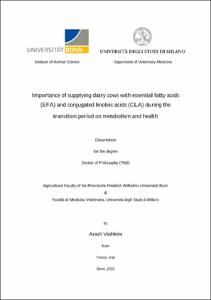Importance of supplying dairy cows with essential fatty acids (EFA) and conjugated linoleic acids (CLA) during the transition period on metabolism and health

Importance of supplying dairy cows with essential fatty acids (EFA) and conjugated linoleic acids (CLA) during the transition period on metabolism and health

| dc.contributor.advisor | Sauerwein, Helga | |
| dc.contributor.author | Veshkini, Arash | |
| dc.date.accessioned | 2022-08-04T12:29:55Z | |
| dc.date.available | 2022-08-04T12:29:55Z | |
| dc.date.issued | 04.08.2022 | |
| dc.identifier.uri | https://hdl.handle.net/20.500.11811/10149 | |
| dc.description.abstract | Ketogenesis and steatosis are common sequelae of the severe mobilization of fat reserves necessary at the onset of lactation when the energy expenditures for milk and maintenance exceed the energy provided by voluntary feed intake in dairy cows. This situation along with a common state of systemic inflammation during early lactation makes dairy cow vulnerable to further metabolic and infectious diseases which impact their profitability. A periparturient supplementation with essential fatty acids (EFA) and conjugated linoleic acids (CLA) has been shown to influence different aspects of lipid and energy metabolisms as well as markers of immune homeostasis in dairy cows. This study aimed at investigating the synergistic effects of EFA, particularly a-linolenic acid (ALA, n-3 fatty acid (FA), and CLA on the liver and plasma proteome profile of dairy cows during the time spanning 3 weeks before to 9 weeks after parturition.
Late-gestation Holstein cows were infused from 9 wk ante partum (AP) to 9 wk post partum (PP) into the abomasum with either coconut oil (CTRL, n = 8, 38 & 76 g/d during dry period and lactation, respectively) or a mixture of EFA (Linseed + safflower oil) and CLA (Lutalin, BASF) (EFA+CLA, n = 8, 60 and 120 g/d during dry period and lactation, respectively). An untargeted shotgun proteomics approach based on liquid chromatography coupled with tandem mass spectrometry was performed in liver biopsies and plasma samples collected at days -21, +1, +28, and +63 relative to calving. At each timepoint, differentially abundant proteins (DAP) between treatment groups were identified as the proteins at the intersection between a multivariate supervised Partial Least Squares Discriminant Analysis (PLS-DA) and an univariate analysis (proteins with P-value <0.05 according to a t-test and fold change = 1.3). In liver a total of 1680 proteins was identified at each timepoint, of which 100 DAP between groups were assigned to the metabolism of xenobiotics by cytochrome P450, drug metabolism - cytochrome P450, drug metabolism - other enzymes, arachidonic acid metabolism, cholesterol metabolism and bile secretion, pyruvate metabolism, steroid hormone biosynthesis, glycolysis/gluconeogenesis, glutathione metabolism, and citrate cycle at all timepoints. At each timepoint, cytochrome P450, as a central hub to these annotated pathways, was related to specific CYP enzymes comprising CYP51A1, CYP1A1, CYP4F2, and CYP4V2. A total of 241 unique proteins was identified in the serum, in which a cluster of apolipoproteins (APO) containing APOC3, APOA1, APOA4, and APOC4 was increased in response to EFA+CLA according to the stage of lactation. Overabundant APO were annotated by GO (gene ontology) terms related to triglyceride (TAG) homeostasis, cholesterol and lipoprotein metabolisms, inflammation, and innate immune response. Altogether, these findings provided novel insights into the molecular mechanisms involved in cytochrome P450, cholesterol, and TAG metabolism by which dietary supplemented EFA+CLA influences metabolic and immune adaptation around parturition. Our results suggest that EFA+CLA could synergistically attenuate hepatic TAG accumulation and marginally mitigate inflammation. Nevertheless, further research is necessary to confirm our results at the other (metabolome) levels. | en |
| dc.language.iso | eng | |
| dc.rights | Namensnennung-Nicht kommerziell 4.0 International | |
| dc.rights.uri | http://creativecommons.org/licenses/by-nc/4.0/ | |
| dc.subject.ddc | 630 Landwirtschaft, Veterinärmedizin | |
| dc.title | Importance of supplying dairy cows with essential fatty acids (EFA) and conjugated linoleic acids (CLA) during the transition period on metabolism and health | |
| dc.type | Dissertation oder Habilitation | |
| dc.publisher.name | Universitäts- und Landesbibliothek Bonn | |
| dc.publisher.location | Bonn | |
| dc.rights.accessRights | openAccess | |
| dc.identifier.urn | https://nbn-resolving.org/urn:nbn:de:hbz:5-66936 | |
| dc.relation.doi | https://doi.org/10.1016/j.jprot.2021.104436 | |
| dc.relation.doi | https://doi.org/10.1016/j.jprot.2021.104435 | |
| dc.relation.doi | https://doi.org/10.1038/s41598-022-09437-w | |
| ulbbn.pubtype | Erstveröffentlichung | |
| ulbbnediss.affiliation.name | Rheinische Friedrich-Wilhelms-Universität Bonn | |
| ulbbnediss.affiliation.location | Bonn | |
| ulbbnediss.affiliation.otherLocation1 | Milano | |
| ulbbnediss.affiliation.otherName1 | Università degli Studi di Milano | |
| ulbbnediss.thesis.level | Dissertation | |
| ulbbnediss.dissID | 6693 | |
| ulbbnediss.date.accepted | 25.05.2022 | |
| ulbbnediss.dissNotes.extern | Dissertation from the European Joint Doctoral Project “Marie Sklodowska-Curie” in Molecular Animal Nutrition of the Horizon 2020 Framework (MANNA 765423) | |
| ulbbnediss.institute | Landwirtschaftliche Fakultät : Institut für Tierwissenschaften (ITW) | |
| ulbbnediss.fakultaet | Landwirtschaftliche Fakultät | |
| dc.contributor.coReferee | Ceciliani, Fabrizio | |
| ulbbnediss.contributor.gnd | 1269460811 |
Files in this item
This item appears in the following Collection(s)
-
E-Dissertationen (1108)




